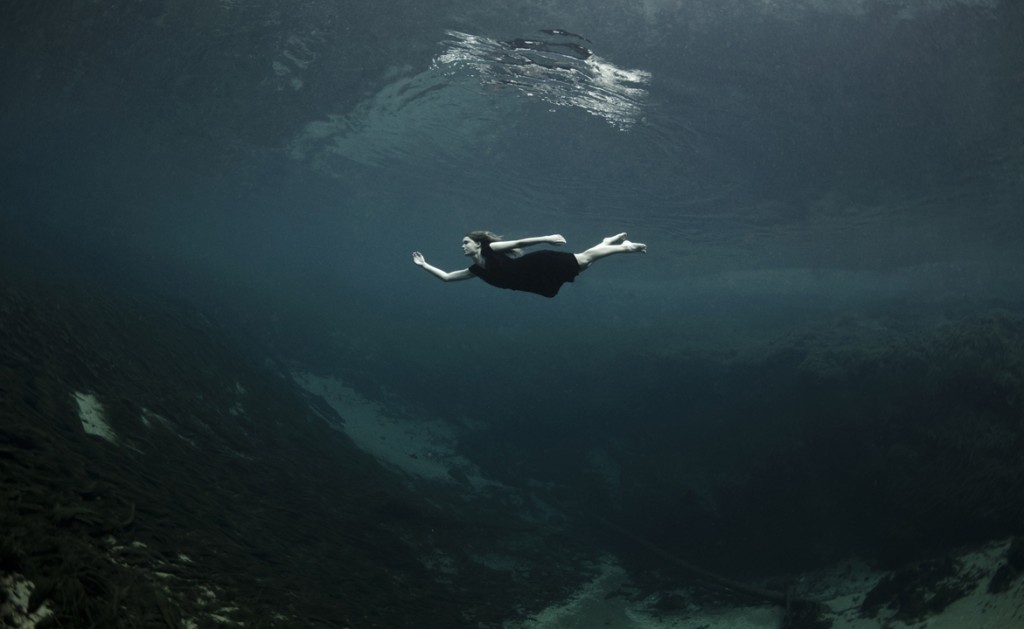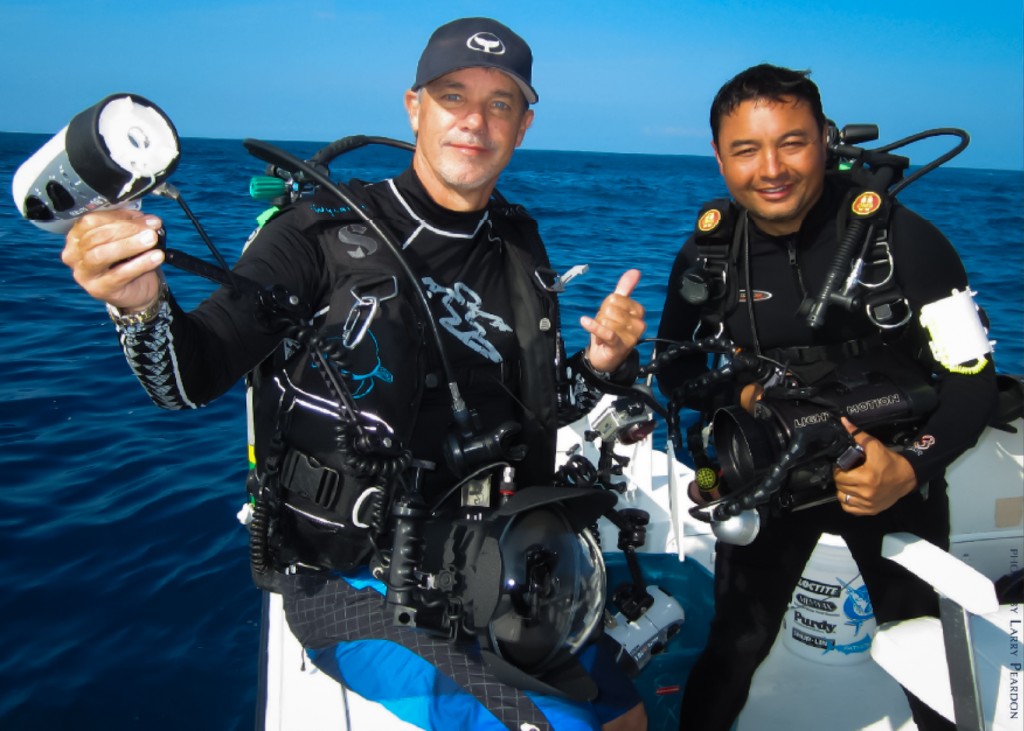The Ocean Artists Society
Text by Charlie Fasano
It started off as an average day that week… pick up marine artist Wyland at the hotel and go shore diving somewhere. This was my third film shoot this year with him and we really synced in our filming and artistic style. The conditions looked good for dolphins so we headed about 30 minutes south. During the ride, he described to me the beginnings of the Ocean Artists Society.
The Beginning
During DEMA 2003, Wyland and fellow marine artists Guy Harvey and Bob Talbot were holding an event together. After the event, they remarked how large the crowd was. They said that they recognised old faces and how some audience members were fans of one artist and some were fans of the other artist. It was then that they brainstormed an idea of collaborating their artwork so as to reach as many people as possible. How can one artist reach the fans of another artist, and visa versa, to deliver the overall message of marine conservation through their artwork? Thus, the birth of the Ocean Artists Society came about. The goal? To collaborate members’ artworks with a mission of delivering a message of marine conservation and environmentalism.
For the last 10 years, that has been the objective of the OAS. Our mission statement is; “Using ocean art to inspire people around the world to a greater awareness of our need to preserve our natural world”. Through the years, artists from around the world have been inducted into the Society with a objective of delivering a message of environmentalism. Inductions have included some real “movers and shakers” in the industry, such as our scientific advisor Dr. Sylvia Earle, David Doubilet, Brian Skerry, James Cameron, Ron and Valerie Taylor, Ernie Brooks, Stan Waterman, Howard and Michelle Hall, Greg MacGillivray, Stephen Frink, Emory Kristof, Michael Aw, Alex Mustard, Amos Nachoum, Flip Nicklin, Doug Perrine, Shawn Heismall nrichs, and Jim Toomey to name a few.
By accumulating these marine artists, each one has been delivering their own message to the masses, but more on an individualistic action. There wasn’t a sense of collaboration except to say that they were part of the same Society. The Society hadn’t really engaged the public with delivering a collaborative message. That’s when Wyland asked me to be the Executive Director, with a job description of being the collaborator.
The Mission
The mission statement stayed the same, but how we delivered our message would become more precise. Wyland knew my editing style since we were in production of two other films – one about Midway Island and another one concerning mermaids. He asked me to make movies for the Ocean Artists Society. It would be my job to create films about certain marine topics every quarter using nothing except the members’ submitted artworks. These topics would be solely about marine conservation. They included Saving Sharks (January 2013), Water Drives Nature (water conservation April 2013), Forests of the Ocean (on coral reefs, July 2013) and Ocean Awareness (October 2013).
The Society
We as a Society use a different medium in conservation. In being a marine artist, it is our responsibility to create a connection between the people who view our artwork and the ocean itself. These films and e-zines are the bridge of our artwork and our message that we deliver to the masses. It is our Society’s collective voice in bringing awareness of the environmental topic. The films are comprised of members-only artworks, including the music and narration. The artists tell their story of how their artwork relates to the environmental topic. Also accompanying the film is our e-zine, Ocean Artists United. The e-zine showcases the individualistic artist and their stance on the topic. It is a visual publication with beautiful imagery and short articles written by the artists themselves. Both the films and e-zine are free and can be viewed or downloaded on any medium, including mobile devices.
The difference of an OAS member and other underwater artists.
There are more underwater artists today than ever before, especially photographers. With more and more people becoming scuba certified and with today’s DSLR technology, it is easy to dive beneath the surface and take hundreds of photos on a single dive. Gone are the days of having to take three cameras on a single dive to obtain 36 exposures, like Stephen Frink and other pioneers. Also gone, unfortunately, is the ease of finding untouched natural beauty; one where man has not had an effect on the ecosystem as Valerie Taylor had so eloquently narrated in our Water Drives Nature film.
There is a new role for today’s underwater artist and especially one who is to be a member of OAS. It is no longer about taking pretty underwater photos and films or painting pretty scenes. It is now about marrying an active conservation message along with their art. Every OAS member is required to prove a correlation of a strong conservation message/action with their artwork. It is our duty to become the new pioneers of underwater imaging but to not only document with aesthetics, but to also educate, drive, and inspire action to reverse the wrongful negative impacts man has had on the Earth. It is our responsibility as underwater artists and this will set our Society apart from other artists and underwater imaging groups.
The “Environmental Renaissance”
This new objective of marine conservation that we wish to deliver to the masses leads us to our “Environmental Renaissance”. During the 1400s in Europe, a renaissance of art, intellect, and science emerged. It took man out of the Dark Ages and opened a new ideology in overall thinking, bringing enlightenment in how man viewed and behaved with the world. Our new “Environmental Renaissance” is what we as Ocean Artists are hoping to initiate. We hope to use art to change man’s intellect and science in moving from the environmental Dark Ages of the Industrial Revolution and move away from this Plastics Age. We want to invoke in man a new enlightened thought to become more environmentally aware to help our Earth.
Now, there’s a further step. Ask yourself, who was the leader of the European Renaissance? Can you name him or her? Exactly! There wasn’t just one single person leading. It was the collective thoughts of man that initiated these new ideologies. And that’s what is needed today. For mankind to come together collectively, without a single leader, and begin the “Environmental Renaissance” to help our Earth.
After discussing the Society during the drive, Wyland and I turned into the bay and checked the waters. It was calm, with the sun coming up behind us over the mountain. The light would be perfect for filming at this angle. We stood on the lava rock and waited for the dolphins to arrive. As we prepared our gear, I spotted several fins in the water over his left shoulder. The dolphins were here. It was time for us to play with them, which was made extra special in the knowledge that our work would be presented as part of an important cause in the future of the new Ocean Artist Society.



